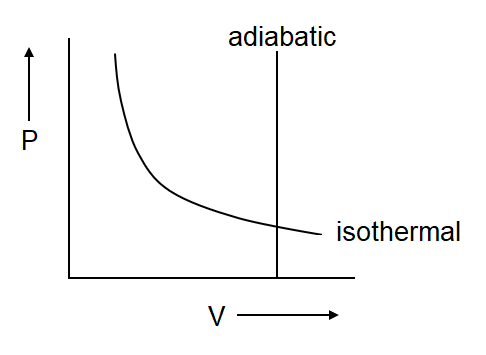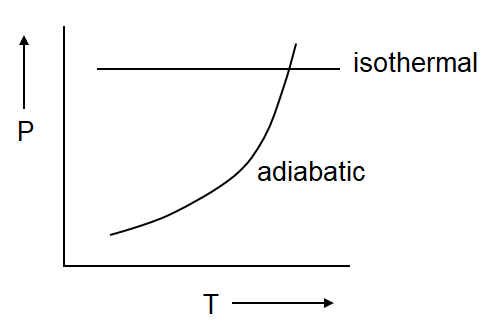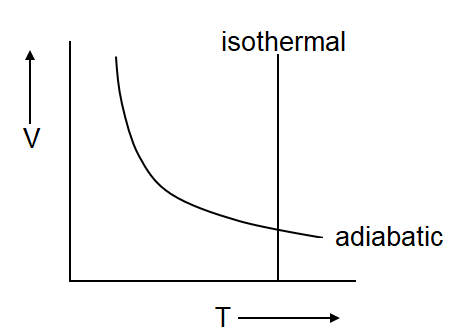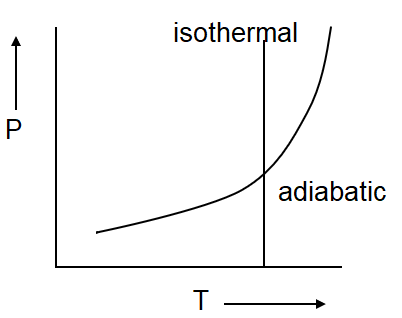
Which one is the correct option depicting the two different thermodynamic processes?
(a) 
(b) 
(c) 
(d) 
A.(c) and (d)
B.(b) and (c)
C.(a) only
D.(c) and (a)
Answer
218.1k+ views
Hint: Look at the given options and the values of x axis and y axis. In thermodynamics, an adiabatic process is defined as the type of thermodynamic process that occurs when heat is not transferred as well as the mass between the thermodynamic system and its surrounding environment. An adiabatic process transfers energy to the surroundings as work only. Whereas an isothermal process is a thermodynamic process in which the temperature of a system does not change means it will remain constant.
Complete step by step solution:
Isothermal process defines the constant temperature which is only possible in the given graph (c) & (d)
For adiabatic process
\[P{V^\gamma }\]= constant …….1
Therefore, we can write
$PV = nRt$
As \[P \propto \dfrac{T}{V}\]
So we have \[\left( {\dfrac{T}{V}} \right){V^\gamma }\]=constant
\[T{V^{\gamma - 1}}\]=constant ……2
Similarly,
\[V \propto \dfrac{T}{P}\]
\[\Rightarrow P{\left( {\dfrac{T}{P}} \right)^\gamma }\]= constant
\[\Rightarrow {P^{1 - \gamma }}{T^\gamma }\]=constant …..3
Therefore, differentiating equation (3) w.r.t temp T
\[{P^{1 - \gamma }}\gamma {T^{\gamma - 1}}dT + {T^\gamma }(1 - \gamma ){P^{1 - \gamma - 1}}dP = 0\]
$\therefore {P^{1 - \gamma }}\gamma {T^{\gamma - 1}}dT + {T^\gamma }(1 - \gamma ){P^{1 - \gamma - 1}}dP = 0$
Hence option A is the correct answer.
Note: In an isothermal process, the transfer of heat into or outside of the system happens too slowly so that thermal equilibrium is maintained throughout the process. At a particular constant temperature T the change of a substance of an object or system is called the Isothermal Process. The adiabatic process is the process in which a system will not receive heat and also not reject heat. In other words, the change in which no heat is supplied from outside as well as heat is not ejected from the gas but the pressure and volume will change are called adiabatic change.
Complete step by step solution:
Isothermal process defines the constant temperature which is only possible in the given graph (c) & (d)
For adiabatic process
\[P{V^\gamma }\]= constant …….1
Therefore, we can write
$PV = nRt$
As \[P \propto \dfrac{T}{V}\]
So we have \[\left( {\dfrac{T}{V}} \right){V^\gamma }\]=constant
\[T{V^{\gamma - 1}}\]=constant ……2
Similarly,
\[V \propto \dfrac{T}{P}\]
\[\Rightarrow P{\left( {\dfrac{T}{P}} \right)^\gamma }\]= constant
\[\Rightarrow {P^{1 - \gamma }}{T^\gamma }\]=constant …..3
Therefore, differentiating equation (3) w.r.t temp T
\[{P^{1 - \gamma }}\gamma {T^{\gamma - 1}}dT + {T^\gamma }(1 - \gamma ){P^{1 - \gamma - 1}}dP = 0\]
$\therefore {P^{1 - \gamma }}\gamma {T^{\gamma - 1}}dT + {T^\gamma }(1 - \gamma ){P^{1 - \gamma - 1}}dP = 0$
Hence option A is the correct answer.
Note: In an isothermal process, the transfer of heat into or outside of the system happens too slowly so that thermal equilibrium is maintained throughout the process. At a particular constant temperature T the change of a substance of an object or system is called the Isothermal Process. The adiabatic process is the process in which a system will not receive heat and also not reject heat. In other words, the change in which no heat is supplied from outside as well as heat is not ejected from the gas but the pressure and volume will change are called adiabatic change.
Recently Updated Pages
Chemical Properties of Hydrogen - Important Concepts for JEE Exam Preparation

JEE General Topics in Chemistry Important Concepts and Tips

JEE Atomic Structure and Chemical Bonding important Concepts and Tips

JEE Amino Acids and Peptides Important Concepts and Tips for Exam Preparation

JEE Extractive Metallurgy Important Concepts and Tips for Exam Preparation

Algebra Made Easy: Step-by-Step Guide for Students

Trending doubts
JEE Main 2026: Application Form Open, Exam Dates, Syllabus, Eligibility & Question Papers

Derivation of Equation of Trajectory Explained for Students

Hybridisation in Chemistry – Concept, Types & Applications

Understanding the Angle of Deviation in a Prism

Understanding Collisions: Types and Examples for Students

Understanding Atomic Structure for Beginners

Other Pages
JEE Advanced Marks vs Ranks 2025: Understanding Category-wise Qualifying Marks and Previous Year Cut-offs

Units And Measurements Class 11 Physics Chapter 1 CBSE Notes - 2025-26

NCERT Solutions For Class 11 Physics Chapter 8 Mechanical Properties Of Solids

Motion in a Straight Line Class 11 Physics Chapter 2 CBSE Notes - 2025-26

NCERT Solutions for Class 11 Physics Chapter 7 Gravitation 2025-26

How to Convert a Galvanometer into an Ammeter or Voltmeter




